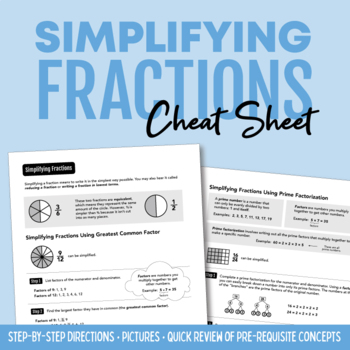Simplifying Fractions Using GCF or Prime Factorization Cheat Sheet
Creative Access
1.5k Followers
Grade Levels
4th - 7th
Subjects
Resource Type
Standards
CCSS4.NF.A.1
Formats Included
- PDF
Pages
2 pages
Creative Access
1.5k Followers
Also included in
- Fractions are introduced in elementary school, but many students haven't mastered them by middle school. When these students need to use fractions in more complex applications, tools like cheat sheets, fraction number lines, and manipulatives can help! This bundle includes all of the above, plus sevPrice $18.00Original Price $21.00Save $3.00
Description
I created this cheat sheet to help my 7th graders with IEPs who are included in the general education classroom. Even though simplifying fractions is typically taught in 4th grade, I found that many of middle schoolers couldn't remember the steps to reduce them. Cheat sheets like this help support more independence when students practice what they've learned. It can also be helpful to parents assisting their children with homework at home.
The resource includes two pages that can be printed as one two-sided cheat sheet. The first side covers:
- What it means to simplify a fraction
- Finding the greatest common factor
- Using the greatest common factor to simplify a fraction
The second side covers:
- Prime numbers, factors, and prime factorization
- Completing a factor tree to find prime factors
- Rewriting the fraction as a set of factors being multiplied together
- Simplifying the fraction by crossing out matching factors
Click "View Preview" to preview the entire product before purchase.
You may also like...
Total Pages
2 pages
Answer Key
N/A
Teaching Duration
Lifelong tool
Report this resource to TPT
Reported resources will be reviewed by our team. Report this resource to let us know if this resource violates TPT’s content guidelines.
Standards
to see state-specific standards (only available in the US).
CCSS4.NF.A.1
Explain why a fraction 𝘢/𝘣 is equivalent to a fraction (𝘯 × 𝘢)/(𝘯 × 𝘣) by using visual fraction models, with attention to how the number and size of the parts differ even though the two fractions themselves are the same size. Use this principle to recognize and generate equivalent fractions.






